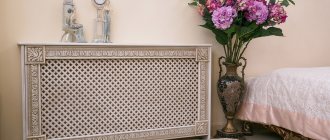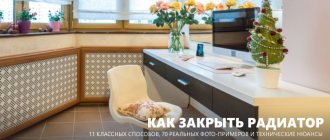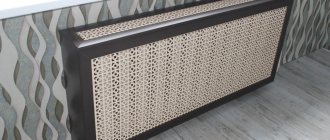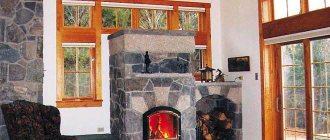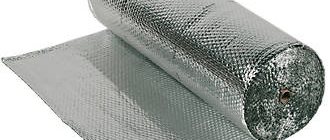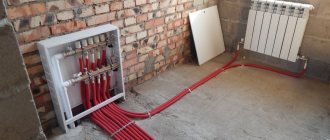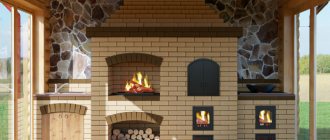The best ways to beautifully hide radiators
There are several ways to hide batteries; in this section we will look at the most popular and effective ones.
Hinged screen
It is by far the most practical and popular method; most often this design is made of metal and has its advantages:
- simple installation;
- heat exchange remains the same;
- can be made with rounded corners, which reduces the risk of injury.
Glass screens
A screen made of glass will be an interesting and stylish solution, especially for those who choose minimalism or a modern style in interior design.
Photo printing or various patterns can be applied to the glass, but this method is not a budget option.
Installation is carried out on a screw holder, but you will have to drill holes in the wall. However, the heating radiator will be stylishly protected. This option will fit into any interior.
Box screens
Box screens are an excellent option for decorating radiators.
- They will help to completely hide the battery.
- The box can become a piece of furniture.
- The screens are easy to install and easy to maintain.
- Protect from burns or other injuries.
Curtains to the floor
Let’s not forget about the most popular way to hide batteries - simply hang them with opaque or translucent curtains. Using this method, over time you will even forget that there are pipes and a radiator behind the curtains.
The main thing is to choose curtains that will look harmonious and not show everyone that there is something behind them.
Painting the walls in color
How to hide a heating radiator on the wall if other designs are “prohibited”. There is only one way to paint it the same color as the wall.
Wood frame
Wood will create coziness and warmth in the apartment, and the disguise of the battery will be elegant and beautiful. This option is for those who are furnishing their home in eco-style using natural materials.
These ways to hide batteries can be used as a stand for home decor.
Built in furniture
Another common way to cover a radiator is custom-made furniture or built-in furniture (shelves, cabinets, folding tables, seating).
Hide the radiator with furniture
Arrange furniture, such as an armchair or desk, so that it covers the radiator. A cast iron radiator is not attractive to many, but pieces of furniture can hide it.
Replace with designer model
For those who don’t want to invent anything, unique designer ways to hide batteries have been developed that already initially have a beautiful appearance and you simply don’t want to hide them.
Using special screens
The screen for the battery must match the design of the room and allow heat to pass through well.
To cover heating radiators in a house or apartment, you can use decorative screens. Choose the one that suits you based on two parameters – design and material of manufacture.
Design features
Masking shields are classified according to the method of fastening to the batteries. According to this principle, screen boxes and hanging products are distinguished.
The decorative box consists of a frame with a large-mesh lattice on the front side. Such products are used when it is necessary to hide the unaesthetic appearance of the battery, and sometimes even the heating circuit pipes. The boxes are installed along the window sill or cover only the radiator. They can be equipped with opening doors, which makes cleaning and temperature control of the coolant easier.
There are two types of hanging grid screens:
- models in the form of a horizontal panel located on top, with a decorative grille built into it;
- options consisting only of the facade part, which are called shields.
The first option is used to hide radiators located in niches or not covered by a window sill on top, and is installed directly on the radiator.
Flat screens mounted to the wall are often placed on radiators under the window, not covered by the window sill. They are also used to hide batteries installed in niches.
Material of manufacture
Plastic screen
To choose a decorative element based on this indicator, you need to take into account the characteristic features of the material.
To mask batteries, screens made of the following materials are used:
- metal;
- wood;
- MDF;
- glass;
- plastic.
To cover unsightly heating radiators, apartment owners most often prefer simple white metal boxes. Such options cannot be called sophisticated, but they are inexpensive and give off heat well. If strength and appearance are important, and cost does not matter, it is better to opt for a stainless steel product, which is characterized by a long service life and aesthetic design. Typically, such decors are used to hide cast iron radiators.
MDF is the most practical and inexpensive material that has all the advantages of wood and at the same time is not afraid of moisture and temperature changes. Screens made of such material are less susceptible to deformation and bending. There are openwork options made from MDF on sale.
Glass panels for heating devices are distinguished by maximum design variability. They are made entirely from glass or with the addition of other decorative materials. The location of the corners must be such that it is impossible to get hurt or caught on clothing. Usually, drawings and patterns are applied to the surface of the product. To prevent glass from breaking or scratches, it is covered with a laminate. In addition to laminated glass, triplex or acrylic is often used.
Plastic screens are the cheapest, but at the same time dangerous option. The shield is subject to deformation from the heat of a hot radiator and releases harmful components into the air. It is not advisable to use such screens where people stay for a long time.
Original ideas
There are many creative ideas that can turn batteries into a decorative element:
Forged products
Hide the radiator with fabric
Painting and decoupage of batteries
In conclusion
Before deciding how to hide the heating radiator, evaluate the reliability and durability of the system . If it does not inspire complete trust, then the best choice is hanging screens that provide quick access to communications. Old cast iron radiators that have been painted many times, as evidenced by smudges, are best hidden behind screens unless you are prepared to remove old layers of paint and sand the surface.
The article was written for the site.
Tags:Heating radiator
Masking of radiators and the laws of heating engineering
The main task of any heating radiator is to heat the room. The goal is achieved by combining or separately using two methods - infrared radiation and convection. Thanks to them, comfortable conditions are formed.
Infrared radiation transfers heat to objects in the room, while convective radiation heats the air.
We can feel thermal energy if we place our hand in close proximity to the radiator. Convection ensures air circulation and uniform temperature distribution throughout the room.
This is known from school physics courses - warm air, rising upward, displaces colder air.
The screen for the radiator performs several important functions: it links the device with the design, protects it from damage and settling dust, the combustion of which releases toxins.
You need to understand that almost any method of hiding pipes and radiators will lead to an inevitable loss of heating power. The simplest example is the use of a glass screen with artistic painting.
It would seem that the task of decorating the radiator was completed successfully, but the room immediately became noticeably colder. This all happened because glass almost completely neutralizes infrared radiation.
An original way to disguise a heating radiator will help to expand the window sill and use the structure as a piece of furniture.
The deeper and more securely the radiator is hidden, the greater the losses will be.
This statement fully applies to blind screens that prevent both long-wave infrared radiation and short-wave convection.
Maximum perforation of the grille and the presence of gaps in the upper and lower parts of the lining are the key to normal convection.
The same can be said about the blind boxes above the top of the radiator - they are an insurmountable barrier to the spread of warm air upward (the convection method does not work). The conclusion suggests itself - the larger the area of the holes in the lining, the smaller the heat loss will be.
Battery screen
Screens come in a variety of shapes and are made from several basic materials. The most popular are metal, wood and glass. Screens made from each of these materials have their own characteristics, advantages and disadvantages. If we talk about metal screens, their use has a very good effect on heat transfer from the battery.
In the photo above you can see an example of the placement of such a mesh-type hanging screen
It is very important when closing a heating battery to always understand that this reduces the efficiency of its operation, and accordingly increases energy costs during the heating season. And metal structures made from such meshes are the least likely to prevent the spread of warm air throughout the room, and therefore are recommended for installation if heating costs become a significant figure in the family budget
If a grid on the wall instead of a radiator doesn't seem like a good idea, then you can look for screens made of solid metal sheets with designs made into them. These images are cut into the surfaces of the screen and make it permeable to warm air flows. Variations of drawings can be very different and choosing a picture that suits your interior will not be difficult.
Second after metal in terms of heat transfer efficiency is the glass screen for the radiator. It is installed on special mounts, which are closed with metal tubes.
The most important advantage of this option for hiding the battery is that absolutely any pictures can be depicted on the glass. Manufacturers actively take advantage of this feature of the material and place the most incredible images on glass screens.
Here we are not just talking about covering up an unsightly element in the interior of a room. Such a screen will be a great addition to the design of a room in almost any style and can even create a separate unique accent in one place or another of the room.
The next way to decorate batteries is to install a wooden box in the place where they are placed. Such a box can be of completely different shapes and colors, and its functional purpose can even hide the very fact of the presence of a battery on the wall.
After viewing these examples, it becomes clear how successful the idea of disguising a heating radiator as a piece of furniture can be. Below are several more options for boxes made in the natural color of wood, which look great in the interior and, in addition to the task of closing the radiator, perform a certain function.
Another good way to keep batteries out of sight is to use a wooden screen with a window sill. With proper space planning, this combination can be used to place several house plants, or to create an additional resting place on the windowsill.
Next, let's look at a few photographs of examples of how you can successfully integrate a heating device into a furniture set along the wall.
And finally, ideas for decorating a heating radiator without closing it. It is not necessary to completely hide the battery; you can include it in the interior elements if you correctly use the shape of the radiator in the process of decorating it.
When choosing a design for closing the battery, try to ensure that there is always access to air from below, and that the top cover is equipped with ventilation holes. The air in the room moves along the radiator from bottom to top and this process ensures effective heat exchange in the room. Cooled air approaches the battery from below and, during the heating process, rises upward along its body. Therefore, when installing a decorative box or screen, always remember that in addition to the aesthetic component, its shape must take into account the peculiarities of heat exchange processes in the room.
Requirements for the decoration of heating radiators
The availability of pipes and radiators is another important point in choosing decor after the requirements of heating engineering. It is well known that the heating radiator, namely the connection with the pipe, is the weakest point.
In addition, the radiator itself, due to improper installation and operation, or for a number of other reasons, may leak.
In emergency cases, it may be necessary to remove the radiator for repair or replacement. From a plumbing point of view, the cover or screen should not have a fixed attachment, ideally the use of attached screens.
Even if you decide to ignore the advice of a plumber, still listen to the voice of reason, which suggests that any weak point in the system is the connection nodes. The presence of an inspection (plastic door) can significantly simplify the task of servicing the radiator and heating system in the future.
No. 7. MDF, chipboard and plastic screens
MDF panels are not inferior to wood, and in some even superior to it; at the same time, they cost 60-70% less and are not so susceptible to changes in humidity and temperature. Externally, such panels can be painted, veneered or laminated, so the variety of appearance is enormous. It is better to select a screen so that it resonates with other elements of the room.
Chipboard screens are not very common due to their not very outstanding performance qualities. Externally, they are not bad, but for use in a residential apartment it is necessary to choose chipboard with a formaldehyde emission level of E0 or E1.
Plastic screens amaze with their variety and low price. The main thing is to make sure that the material is safe by studying the accompanying documentation. For screens, plastic should be used that can easily withstand heat up to 60-800C. Such products are great for bathrooms, as they are hygienic and do not require maintenance.
How to close batteries correctly - technical rules and tips
Before closing the radiator, you need to take into account several technical nuances:
- Keep in mind that the heat transfer of a closed radiator is reduced in any case, no matter what masking method you choose. The main thing is that the change is not significant.
Ideally, the decrease in air temperature in the room should be about 1-1.5 degrees.
- Before closing the battery, put it in order: blow it out, wash it (this is done at the end of the heating season) and paint it.
- Keep in mind that the denser the grille weave, the better it masks the radiator, but the worse it conducts heat. Therefore, when choosing a screen for a battery, try to look for a middle ground or rely on heat saving.
- To minimize heat loss, the screen can be placed on legs and a groove can be cut in the center.
When closing the battery, it is very important not to block convective air flows, otherwise it will blow in the room and the windows will begin to fog up, which will ultimately lead to the appearance of mold on the walls. Ideally, the window sill visor should protrude no more than 30 mm above the radiator; the top and bottom of the radiator should be as open as possible.
- There should be a distance of at least 35-50 mm between the battery and the screen. There should be a gap of about 60-70 mm from the radiator to the floor and to the window sill.
To resolve emergency situations, it is necessary to provide free access to the radiator. For example, the box grille can be removable, folding, opening on hinges or retractable on profiles.
At a minimum, for trouble-free maintenance, the following must remain in good accessibility: pipe connections, valves, thermal head and threaded connections.
You can increase heat transfer by 20-25% by placing a heat-reflecting screen, for example, fumisol, on the wall behind the radiator. Often this is quite enough to completely compensate for the heat loss of a closed battery.
What to consider when masking a battery
Before you start masking, you need to know a few important nuances:
- The first thing you need to understand is that with any method there will be heat loss.
- Convection air flows should not be blocked by anything; this is the only way to maintain uniform heating of the room, and the windows will not fog up.
- For various emergencies, it is worth considering in advance free access to threaded connections and the radiator - this could be a window or a removable structure, for example, a door with hinges.
- For repairs, the faucet, thermal head and other elements of the heating system must remain in good accessibility.
Hide with drywall
Separately, I would like to talk about how you can hide batteries using drywall. It’s worth noting right away that the material has its drawbacks, but plasterboard construction is still very popular for repairs.
- The material is environmentally friendly and is not subject to combustion.
- You can find several varieties of this material on the market.
- This camouflage option is budget-friendly, and installation can be carried out in different ways, in a way that is convenient for you.
- Also, it is drywall that will allow the apartment owner to come up with any design, which will help not only to cover the pipes and radiator, but also to make additional decorative elements.
The downside is that drywall is afraid of external influences; if you do it carelessly, it is quite easy to break or pierce it.
And if a breakdown or leak occurs, the entire finish will have to be replaced again, but this material is cheap.
Simple ways to protect your summer veranda from snow and rain
Typically, the meaning of a veranda is the additional area of a house or cottage, which often plays the role of a balcony or open area.
Quite often this is something like a greenhouse or winter garden. Often the veranda is an additional extension of the cottage.
Today, few standard projects involve the construction of a veranda simultaneously with the construction of a particular house. For this reason, many people build verandas on their own.
Most often, such a structure is already a closed roof or canopy, since it is much more convenient to enjoy fresh air and the landscape when the hot rays of the sun are not shining from above and the rain is not dripping.
Sometimes it all starts with creating such a site or simply trying to expand the living space. Open verandas look extremely tempting in the summer, allowing you to have a good rest and enjoy the freshness of nature.
However, with the onset of colder evenings, its use becomes extremely difficult and inconvenient.
That is why many resort to solutions such as closing verandas from unfavorable factors and even insulation, which provides this building with the actual status of part of the house.
https://youtube.com/watch?v=5Tl5cF_V3TY
Today, there are a large number of ways that allow you to close the veranda from a wide variety of adverse natural phenomena.
In addition, it is better to think about the possibility of insulating the veranda at the initial construction stage. Subsequent reworking of the basic design into an insulated one may require additional costs and be much more labor-intensive than the initial design.
Do-it-yourself installation of a plasterboard box
In order to close the battery, you need to measure it, and then buy metal profiles and other additional products.
What materials are needed:
- 12 mm plasterboard sheet,
- metal profiles 27x28 and 60x27,
- self-tapping screws for drywall and metal,
- dowel-nails size 6x40,
- construction serpyanka,
- perforated corners.
Tools:
- screwdriver,
- hammer drill,
- metal scissors,
- stationery knife,
- construction stapler,
- pencil,
- roulette,
- building level.
Attention , for the construction of a plasterboard box there is an important requirement : the window sill must extend beyond the radiator by at least 3 centimeters.
Work order:
Installation of the frame. The profile should be mounted on three adjacent sides: floor, wall, window sill.
- Press the 27x28 metal profile to the base with your hand, drill a hole using a hammer drill in both the profile and the wall.
- Using a screwdriver, screw the dowel-nail into the hole.
- At the bottom of the window sill, a 27x28 metal profile is mounted on self-tapping screws; the length of the screws should not be greater than the thickness of the window sill.
- Next, you can install jumpers made of metal profile 60x27.
Selecting the grid size. This hole must be made slightly smaller than the grid size.
You can focus on three recommended sizes: 60x120, 60x90 or 60x60.
Installation of drywall. Plasterboard sheets can be cut with a utility knife. Screw it in with a screwdriver.
Installation of corners. They must be secured at the corners with a construction stapler, or attached to gypsum plaster.
- Serpyanka should be applied to all seams of the plasterboard box and covered with plaster.
- Before painting or wallpapering, the plasterboard box must be puttied, sanded and coated with primer.
Hide behind furniture
In front of the radiator, at some distance from it - for the same air circulation, you can put a small sofa, chest of drawers or console - anything, the height of the window sill and the width of the radiator or wider. This method does not require any costs, only rearranging the furniture.
It is better not to place very deep objects near the radiator, so that it is still convenient to open the window. This is definitely not the place for the head of the bed: the proximity of radiators will cause headaches, not to mention simply an uncomfortable temperature during sleep.
Masking heating pipes
It doesn’t matter whether it’s an apartment or a house, a bedroom or a kitchen, everywhere I would like to have a good renovation. Questions immediately arise: how to beautifully hide heating pipes and how can this be done with minimal cost and maximum efficiency?
At the same time, the method of disguise should be truly invisible and unnoticeable, fitting into the room.
The pipe can be hidden inside the wall, or it can also be closed into the floor. Remember that the old heating system should not be hidden in this way; this option is possible after a complete update of all elements.
Box on frame
It is best made from wood, plastic or plasterboard. Do not place the heating pipes close together; there should be at least three centimeters between the box and the pipe.
Hide behind decor
Decoration of pipes in various ways, for example, wrapping them with jute rope. But remember that this reduces heat transfer. Many owners decorate pipes with flowers; this can be done using bamboo with leaves.
Only imagination should work here; even an old pipe can look completely different.
Painting to match the color of the walls
The easiest and most practical method is to paint the radiators or riser in the same color as the walls, but the heat generation will not be reduced.
Hide under the floor plinth
A good invention was the floor plinth, in which you can easily hide batteries located horizontally and low to the floor.
How to hide a pipe
An open method of masking a pipe
Sometimes it is necessary to hide not only the radiator itself, but also the pipe sections connected to it. Different methods are used for this:
- Open method. The fastest. The pipes are painted to match the color of the walls, making them almost invisible. The idea of decorating with available materials, for example, painting a heating element to match the color of wood and attaching twigs to it, can also be interesting and original.
- Hidden broach. The pipes are hidden in grooves in the wall and covered with cladding. The downside is that in the event of a breakthrough, the casing will have to be opened, so this method is absolutely not suitable for old wiring.
- Packing in floor screed. This method of laying a highway is suitable if the concrete layer has not yet been poured. It also requires labor-intensive opening in the event of an accident, so a plan for laying communication lines should be kept in case of repair of the heating system.
- Covered with a wide plinth. This is possible if the heating pipes run along the floor. If a similar arrangement of the heating circuit is in the bathroom or kitchen, you can make a structure similar to a stair step and decorate it with tiles.
A good option is to use false walls. You can hide anything you want behind a decorative partition, including heating elements. But the false wall must be quickly dismantled to ensure easy access in the event of an accident. The easiest way is to create a frame bulkhead from timber or metal profiles and cover it with plasterboard, plastic or plywood. It is useful to place hatches with flaps at the places where pipes are connected to the heating device and where couplings and tees are located. It is good if the area of the room allows you to install the decorative covering not close to the radiator, so that it does not heat up too much and does not emit potentially dangerous substances.
Knowing how to decorate pipes or heating radiators in an apartment or private house, you can easily solve the problem of masking a utility junction. Decorative ceilings will improve the appearance without reducing the efficiency of heating the premises. Also, a beautiful screen will allow you to get rid of long, dust-collecting curtains in favor of modern roller or Roman curtains.
Photos in the interior of the rooms
Kitchen
The kitchen is the ideal room in which all ways to hide batteries will become practical and convenient.
If the room is small, then you can hide the radiator with the help of a beautiful tabletop or make a folding table, which will fold out when convenient.
Factories of metal-plastic structures offer a large selection of beautiful large-sized window sills that imitate stone, wood and other materials. A modern window sill does not break under weight, is not afraid of external factors, is easy to care for, wipe clean, is not afraid of scratches, and so on.
You can hide any type of battery in this way, including cast iron.
Living room
If the radiator is in a niche, then a wide window sill will help create a work area.
You can place souvenirs, vases or potted flowers on the constructed wooden box. You can also cover unsightly radiators in the living room with thick curtains.
The photo shows a modern living room. In order to hide the radiators, a wooden structure was installed, which also serves as a place for rest, storage and decoration.
Bedroom and children's room
In the interior of a bedroom and children's room, batteries can be used as another place to relax, a tabletop for decorative elements or a workplace.
Bathroom
You can hide the pipes in the bathroom using a louvered door, plastic grilles or a cabinet with opening doors.
We hide heating radiators using wooden, glass or plastic screens.
Hallway
For radiators in hallways, glass screens or wooden boxes are suitable. In a small room, covering the battery is only necessary from a practicality point of view.
This could be a locker for storing shoes, or the battery will become a small coffee table where keys and other necessary items will be stored.
Beauty at the expense of warmth
During a major renovation of premises, you can, of course, hide the battery in the wall using a niche made of plasterboard, chipboard or plastic. Ventilation of heat and removal of it from the battery, in this case, is carried out through a grille, which must be installed in such a niche. As a rule, such niches are decorated with a grating made of chipboard or wood. It is possible to select both the grille itself and its frame in the required color scheme. These grates are sold in a wide range, they are durable and transmit heat well.
Reading bench above the radiator
In addition, the issue of converting heating radiators can be solved by covering them with special decorative screens. Such devices can be installed directly in front of the heating radiators or in a hinged form.
Hanging screen made of thin wooden slats
A simple wooden lattice painted to match the wall trim
A hanging metal screen slightly reduces heat transfer, is inexpensive and easy to install
These solutions cannot always be called optimal, since a very large part of the heat generated by the battery is wasted in this case. The effect is close to what would be achieved by hiding the battery behind the curtains.
Metal screen with openwork design
Any screen design must provide access to the radiator
At the same time, closing heating radiators serves the function of protecting small children from burns. Screens, boxes and niches are beautiful and can be matched to any interior. This type of decor is usually used in living rooms and is an ideal stylistic solution for them. Covering radiators in children's rooms with boxes and screens is the optimal solution for both safety and decorative purposes. A panel made of wood or chipboard can be decorated with bright patterns and used as a play element.
Screen idea for high battery
An old wooden bench used as a battery box in the hallway of a village house
How to beautifully decorate radiators
Installing a decorative box to cover heating radiators is not the only solution, and not everyone can come up with something and do it on their own.
There are several more ways on how and with what to decorate radiators under the window.
Radiator painting
One of the important issues in decorating a room is the combination of colors. Well, how can a white radiator look, for example, on a dark wall? Although for some reason white color is considered ideal for batteries...
The choice of heat-resistant paints on the modern construction market is huge; all that remains is to choose the right shade and tint the white base.
Even if you don’t guess the shade by a couple of tones, it’s okay, such a difference seems not noticeable at all. But it will still be better than just white. Well, if you wish, you can also manually paint the batteries, especially if there is an ornament on the wallpaper. To make the work easier, you can use a stencil.
Remember: if you decide to paint the radiators in your apartment, buy only heat-resistant paints.
By the way, you can paint not only ordinary cast iron radiators, but also steel, bimetallic, and aluminum ones.
Fabric screen
Another decor option is sewing and attaching a fabric screen screen. This masking method has been tested and is quite effective in terms of minimal heat loss, since the fabric, even the densest, still allows warm air to pass through (unlike a hard screen).
Previously, when heavy curtains were in fashion, all the radiators and the pipes suitable for them were hidden behind them.
And now, when Roman or roller blinds that do not reach the floor are used everywhere, we have to invent something. A practical solution is to attach Velcro to the bottom of the window sill and sew the other half of the adhesive tape to the fabric to create a removable fabric screen.
You can choose the material for it according to your taste and financial capabilities - from thin curtains, to natural linen or cotton, or vertical strips of blinds. The only condition is that the fabric can withstand temperatures up to 60 degrees.
Well, having arranged the space under the window in this way, you can choose roller blinds or window blinds as protection from the sun, without worrying about the unsightly appearance of radiators.
Heating battery box
Most often, such structures are either mounted on the wall or are attached, making it easier to maintain communications. Such boxes are made mainly from MDF, chipboard, wood or plywood.
The first option is the most practical, since MDF does not dry out and is not exposed to temperature changes, and it can be given any shape.
A prerequisite for such a design is the presence of perforations (holes), and the larger they are, the more heat will enter the room. There must be a hole at the bottom for the influx of cold air, and at the top for the exit of warm air.
You can use ordinary wooden blocks as a frame for the box, and if you have the skills of a carpenter, you can build a box according to individual dimensions: it can be either a structure the entire width of the room, covering both the radiator and pipes, or a box covering only the radiator.
Usually, the installation of a box that hides radiators is accompanied by dusty work, so you need to think through the design and create a sketch at the beginning of the repair. A decorative box can not only hide nondescript radiators that are unnecessary to the eye, but also become an element of interior decoration.
Hard screen
The most common (but, unfortunately, not the most practical) solution is to install a hard screen; hardware stores even offer ready-made solutions from a variety of materials. Each of them has its own disadvantages and advantages over others.
- Made of metal. For production, as a rule, stainless steel is used, followed by painting or chrome elements. Such structures look like ordinary mesh boxes. Of course, a metal object under the window is not suitable for every room; the ideal style for such a solution is hi-tech or loft.
But this design conducts heat well and will last a long time.
- Made of wood. Wood has always been considered a win-win option, as it fits into almost any interior. Wooden screens are a structure in the form of wooden lamella panels, horizontal or vertical, located at a sufficient distance from each other. Thanks to good perforation, such a grille does not interfere with proper convection; a wooden screen for a heating radiator will be a reasonable solution.
The only condition is that it must fit perfectly into the environment. This can be achieved by making a custom-made design with tinting to match the furniture.
- Made from glass, it will fit perfectly into the interior of any room. The glass can be frosted or colored, almost completely covering the radiator, or it can have a pattern that matches the style of the room. However, along with the elegant and airy appearance, there is one huge drawback - heat loss in the absence of perforation will almost double. Even the thermal gap at the top and bottom of the screen does not help the situation.
You can improve air circulation by using not solid glass, but glass panels located at some distance from each other.
- From plasterboard. Of course, we are talking, rather, about drywall as the basis of the screen itself, and with the help of other materials you can make a decorative panel-overlay that covers the batteries flush with the box itself.
When installing such a structure, you need to remember all the laws of heating engineering and safety, leaving access to communications in the event of a leak or the need to replace batteries.
The history of radiators
A couple of centuries ago, fireplaces and stoves, which were heated with coal or wood, were responsible for heating the house. In many Russian villages these units are still preserved and are still used for their intended purpose. The first prototype of the heating system is considered to be the Roman hypocausts. They were a set of channels that ran under the floor and connected to the stove. Warming up of the premises occurred due to hot air. Roman baths were heated with water running through copper pipes. The liquid was also heated in the furnace. Thus, in Ancient Rome there were two types of heating systems: steam and water. The ovens themselves were first made of clay, then of stone and brick.
The furnace revolution was carried out by Benjamin Franklin, known largely for his political activities. The inventor used cast iron to make the stove. The metal took a long time to heat up, but also cooled down slowly. The cast iron unit became the prototype of two modern inventions at once: boilers and radiators. The next to show his ingenuity was an English engineer who, based on the Franklin stove, created a complex water heating system for heating a winter garden. The liquid was heated in large volume boilers. The water then entered the pipes, where it circulated, giving off heat, and returned to be reheated. This idea was adopted not only by English engineers, but also by domestic ones.
Similar units were used to heat the Summer Palace in the Peter the Great era. The systems used conventional pipes, which still did not heat the air well due to their small area. The first to come up with a cast iron radiator, which was a system of disks and a pair of thick pipes connected to a boiler, were domestic inventors. Such batteries quickly spread throughout Europe and beyond. However, gravity heating systems eventually replaced units that operated on pumps. In them, the liquid spread along communication lines as a result of forced injection. Closer to the 30s of the last century, tubular radiators came to replace cast iron radiators. After another thirty years, aluminum batteries began to be used. Starting in the 20s, they began to introduce an innovative (at that time) centralized heating system, which is still in use today.
Examples in different interior styles
Modern style
For a modern style or a high-tech and minimalist style, any material made of wood, glass (glass panels) or metal is suitable.
Classic style
It is recommended to use natural materials; it is better to opt for a wooden lattice.
Provence
Wood also loves styles such as Provence, country, chalet and eco-style.
Scandinavian
Wooden grilles in light colors will look appropriate in the Scandinavian style.
Loft
In the loft style, old radiators and pipes are most often not covered; they are left on display or replaced with interesting design options.
The best solutions for the kitchen
The design of kitchens, not as strict as is customary for living rooms, gives free rein to imagination. In addition to the above-described ways to hide heating radiators, in the rooms where culinary masterpieces are created, designer delights are also created to decorate heating radiators. The radiator and the pipe connecting it to the heat source can be painted in the same color as the walls, decorated using the decoupage technique, or these two methods can be combined.
A battery painted to match the walls will be less conspicuous
An even greater effect can be achieved if you paint the battery to match the wallpaper
The battery can be displayed as part of an artistic composition
Many ideas are available on the Internet. Taking them as a basis, you can create a masterpiece on your own and without much labor or time, decorating the external elements of the heating system with an elegant or cheerful design. Battery decoupage involves transferring a design from a carrier onto the metal surface of a radiator. When decorated using the decoupage technique, batteries can be decorated using ready-made designs made on thin paper (both rice paper and ordinary decorative napkins are suitable). There are a lot of design options: flowers, wood decoration, geometric designs.
Khokhloma painting on a heating radiator
If you have artistic abilities, then you can do without ready-made solutions and apply paint directly to the surface. For such work you will need heat-resistant paints and varnish. The latter is necessary for those who decide to decoupage the battery themselves. For decoupage you will also need glue; regular PVA will do.
How to close a radiator: photo gallery
Cover with curtain
Instead of a screen, you can use fabric. This method makes sense if the battery is recessed into the window opening, then the curtain is simply attached from below to the window sill using Velcro. You can make it from the same fabric as the curtains themselves, or choose a cut to match the wallpaper. This solution looks especially good in vintage and rustic styles.
Paint
If you are a creative person, and this is reflected in the interior, you can paint the battery with an ornament or give it the appearance of a fantastic animal or a box of pencils. However, such creativity will attract a lot of attention to the battery, especially against the backdrop of a fresh renovation - is this exactly what you wanted?
You will find more battery options that do not spoil the interior in the article “Radiators in the interior.”
Photos: grishaenkova.ru, pricedv.ru, jacekpartyka.com, home-designing.com, bertibarbera.com, furnirior.com, pinterest.com, ofdesign.net
Add to favorites15
- Tags
- battery
- decor
- with your own hands
battery, decor, do it yourself
